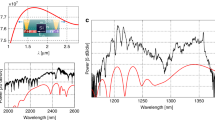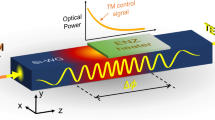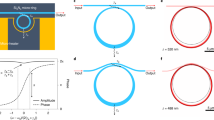Abstract
High-bandwidth, low-power and compact silicon electro-optical modulators are essential for future energy-efficient and densely integrated optical data communication circuits. The all-silicon plasma-dispersion-effect ring resonator modulator is an attractive prospect. However, its performance is currently limited by the trade-off between modulation depth and switching speed, dictated by its quality factor. Here we introduce a mechanism to leap beyond this limitation by harnessing the plasma absorption induced in a silicon metal–oxide–semiconductor waveguide to enhance the extinction ratio of a low-quality-factor, high-speed ring modulator. The fabricated devices demonstrate a modulation depth of ~27 dB for a bias of ~3.5 V. Modulation enhancement has been observed for operation frequencies ranging from kilohertz to gigahertz, with data modulation up to 100 Gbit s−1 on–off keying demonstrated, paving a way to the evolution of optical interconnects to 100 Gbaud and beyond per wavelength.
This is a preview of subscription content, access via your institution
Access options
Access Nature and 54 other Nature Portfolio journals
Get Nature+, our best-value online-access subscription
$29.99 / 30 days
cancel any time
Subscribe to this journal
Receive 12 print issues and online access
$209.00 per year
only $17.42 per issue
Buy this article
- Purchase on Springer Link
- Instant access to full article PDF
Prices may be subject to local taxes which are calculated during checkout





Similar content being viewed by others
Data availability
The data that support the results within this paper are available in the Supplementary Information and at the University of Southampton repository (https://doi.org/10.5258/SOTON/D1909). Source data are provided with this paper.
References
Reed, G. T., Mashanovich, G., Gardes, F. Y. & Thomson, D. J. Silicon optical modulators. Nat. Photon. 4, 518–526 (2010).
Thomson, D. et al. Roadmap on silicon photonics. J. Opt. 18, 073003 (2016).
Reed, G. T. et al. Recent breakthroughs in carrier depletion based silicon optical modulators. Nanophotonics 3, 229–245 (2014).
Rahim, A. et al. Taking silicon photonics modulators to a higher performance level: state-of-the-art and a review of new technologies. Adv. Photonics 3, 024003 (2021).
Wang, C. et al. Integrated lithium niobate electro-optic modulators operating at CMOS-compatible voltages. Nature 562, 101–104 (2018).
He, M. et al. High-performance hybrid silicon and lithium niobate Mach–Zehnder modulators for 100 Gbit s−1 and beyond. Nat. Photon. 13, 359–364 (2019).
Abel, S. et al. Large Pockels effect in micro- and nanostructured barium titanate integrated on silicon. Nat. Mater. 18, 42–47 (2019).
Alexander, K. et al. Nanophotonic Pockels modulators on a silicon nitride platform. Nat. Commun. 9, 3444 (2018).
Kieninger, C. et al. Ultra-high electro-optic activity demonstrated in a silicon-organic hybrid modulator. Optica 5, 739–748 (2018).
Lu, G. W. et al. High-temperature-resistant silicon-polymer hybrid modulator operating at up to 200 Gbit s−1 for energy-efficient datacentres and harsh-environment applications. Nat. Commun. 11, 4224 (2020).
Srinivasan, S. A. et al. 60 Gb/s waveguide-coupled O-band GeSi quantum-confined Stark effect electro-absorption modulator. In Optical Fiber Communication Conference (OFC) 2021, Dong, P. et al. (eds) (Optica Publishing Group, 2021); https://doi.org/10.1364/OFC.2021.Tu1D.3
Mastronardi, L. et al. High-speed Si/GeSi hetero-structure electro absorption modulator. Opt. Express 26, 6663–6673 (2018).
Srinivasan, S. A. et al. 56 Gb/s germanium waveguide electro-absorption modulator. J. Light. Technol. 34, 419–424 (2016).
Han, J. H. et al. Efficient low-loss InGaAsP/Si hybrid MOS optical modulator. Nat. Photon. 11, 486–490 (2017).
Jayatilleka, H. et al. Post-fabrication trimming of silicon photonic ring resonators at wafer-scale. J. Light. Technol. 39, 5083–5088 (2021).
Li, H. et al. A 3-D-integrated silicon photonic microring-based 112-Gb/s PAM-4 transmitter with nonlinear equalization and thermal control. IEEE J. Solid State Circuits 56, 19–29 (2021).
Nedeljkovic, M, et al. Free-carrier electrorefraction and electroabsorption modulation predictions for silicon over the 1-14-μm infrared wavelength range. IEEE Photonics J. 3, 1171–1180 (2011).
Phare, C. T., Daniel Lee, Y.-H., Cardenas, J. & Lipson, M. Graphene electro-optic modulator with 30-GHz bandwidth. Nat. Photon. 9, 511–514 (2015).
Nitkowski, A., Chen, L. & Lipson, M. Cavity-enhanced on-chip absorption spectroscopy using microring resonators. Opt. Express 16, 11930 (2008).
Abel, S. et al. A hybrid barium titanate-silicon photonics platform for ultraefficient electro-optic tuning. J. Light. Technol. 34, 1688–1693 (2016).
Sharif Azadeh, S., Merget, F., Nezhad, M. P. & Witzens, J. On the measurement of the Pockels effect in strained silicon. Opt. Lett. 40, 1877–1880 (2015).
Sharma, R., Puckett, M. W., Lin, H. H., Vallini, F. & Fainman, Y. Characterizing the effects of free carriers in fully etched, dielectric-clad silicon waveguides. Appl. Phys. Lett. 106, 241104 (2015).
Sun, J. et al. A 128 Gb/s PAM4 silicon microring modulator with integrated thermo-optic resonance tuning. J. Light. Technol. 37, 110–115 (2019).
Hu, C. Modern Semiconductor Devices for Integrated Circuits (Prentice Hall, 2010).
Müller, J. et al. Optical peaking enhancement in high-speed ring modulators. Sci. Rep. 4, 6310 (2014).
Sakib, M. et al. A high-speed micro-ring modulator for next generation energy-efficient optical networks beyond 100 Gbaud. In Conference on Lasers and Electro-Optics, Kang, J. et al (eds) S. (Optica Publishing Group, 2021); https://doi.org/10.1364/CLEO_SI.2021.SF1C.3
Sakib, M. et al. A 240 Gb/s PAM4 silicon micro-ring optical modulator. In Optical Fiber Communication Conference (OFC) 2022, Matsuo, S. et al (eds) (Optica Publishing Group, 2022); https://doi.org/10.1364/ofc.2022.m2d.4
Zhang, W. et al. Integration of low loss vertical slot waveguides on SOI photonic platforms for high efficiency carrier accumulation modulators. Opt. Express 28, 23143 (2020).
Zhu, S., Lo, G. Q., Ye, J. D. & Kwong, D. L. Influence of RTA and LTA on the optical propagation loss in polycrystalline silicon wire waveguides. IEEE Photon. Technol. Lett. 22, 480–482 (2010).
Li, K. et al. Electronic-photonic convergence for silicon photonics transmitters beyond 100 Gbps on-off keying. Optica 7, 1514–1516 (2020).
Hashemi Talkhooncheh, A. et al. A 100-Gb/s PAM4 optical transmitter in a 3-D-integrated SiPh-CMOS platform using segmented MOSCAP modulators. IEEE J. Solid-State Circuits 58, 30–44 (2023).
Tong, Y. et al. An experimental demonstration of 160 Gbit/s PAM-4 using a silicon micro-ring modulator. IEEE Photon. Technol. Lett. 32, 125–128 (2020).
Zhang, Y. et al. 240 Gb/s optical transmission based on an ultrafast silicon microring modulator. Photon. Res. 10, 1127–1133 (2022).
Acknowledgements
This work was supported by funding from Rockley Photonics and the EPSRC through the Prosperity Partnership (EP/R003076/1), EPSRC Platform Grant (EP/N013247/1), EPSRC Strategic Equipment Grant (EP/T019697/1) and European Commission H2020 PICTURE Project (780930). D.J.T. acknowledges funding from the Royal Society for his University Research Fellowship (UF150325).
Author information
Authors and Affiliations
Contributions
W.Z. contributed to the idea, simulation, fabrication, device testing and manuscript preparation. K.L. contributed to device testing. M.E., B.C., X.Y., H.D., M.B., D.T.T. and C.G.L. contributed to device fabrication. A.S., G.Y., R.S., A.Z. and G.R. contributed to the discussion, and G.R. manages the Silicon Photonics Group at Southampton. D.J.T. provided high-level project supervision and manuscript revision.
Corresponding author
Ethics declarations
Competing interests
Authors A.S., G.Y., R.S., A.Z., G.R. and D.J.T. are shareholders of Rockley Photonics Holdings Limited (NYSE: RKLY), a global leader in photonics-based health monitoring and communications solutions.
Peer review
Peer review information
Nature Photonics thanks Stanley Cheung and the other, anonymous, reviewer(s) for their contribution to the peer review of this work.
Additional information
Publisher’s note Springer Nature remains neutral with regard to jurisdictional claims in published maps and institutional affiliations.
Supplementary information
Supplementary Information
Supplementary discussion, Supplementary Figs. I-1, I-2, I-3, I-4, I-5, I-6, I-7, I-8, II-1, II-2, III-1, III-2, III-3, III-4, III-5, IV-1, IV-2 and IV-3 and Supplementary Tables III-1 and IV-1.
Supplementary Data
Original data for Fig. I-1.
Supplementary Data
Original data for Fig. I-2, Fig. I-3, Fig. I-4.
Supplementary Data
Original data for Fig. I-5.
Supplementary Data
Original data for Fig. I-6.
Supplementary Data
Original data for Fig. I-7.
Supplementary Data
Original data for Fig. I-8.
Supplementary Data
Original data for Fig. III-1.
Supplementary Data
Original data for Fig. III-3/4/5.
Supplementary Data
Original data for Fig. I-1.
Supplementary Data
Original data for Fig. I-2.
Supplementary Data
Original data for Fig. I-3.
Source data
Source Data Fig. 1
Source data of image of the device in Fig. 1.
Source Data Fig. 2
Source data of optical transmission data in Fig. 2.
Source Data Fig. 3
Source data of optical transmission and image containing data in Fig. 3.
Source Data Fig. 4
Source data of bandwidth and eye diagram image of Fig. 4.
Source Data Table.1
Source data of bandwidth and eye diagram image of Fig. 5.
Rights and permissions
Springer Nature or its licensor (e.g. a society or other partner) holds exclusive rights to this article under a publishing agreement with the author(s) or other rightsholder(s); author self-archiving of the accepted manuscript version of this article is solely governed by the terms of such publishing agreement and applicable law.
About this article
Cite this article
Zhang, W., Ebert, M., Li, K. et al. Harnessing plasma absorption in silicon MOS ring modulators. Nat. Photon. 17, 273–279 (2023). https://doi.org/10.1038/s41566-023-01159-3
Received:
Accepted:
Published:
Issue Date:
DOI: https://doi.org/10.1038/s41566-023-01159-3
This article is cited by
-
Sub-volt high-speed silicon MOSCAP microring modulator driven by high-mobility conductive oxide
Nature Communications (2024)
-
A 5 × 200 Gbps microring modulator silicon chip empowered by two-segment Z-shape junctions
Nature Communications (2024)
-
On-chip silicon electro-optical modulator with ultra-high extinction ratio for fiber-optic distributed acoustic sensing
Nature Communications (2023)



